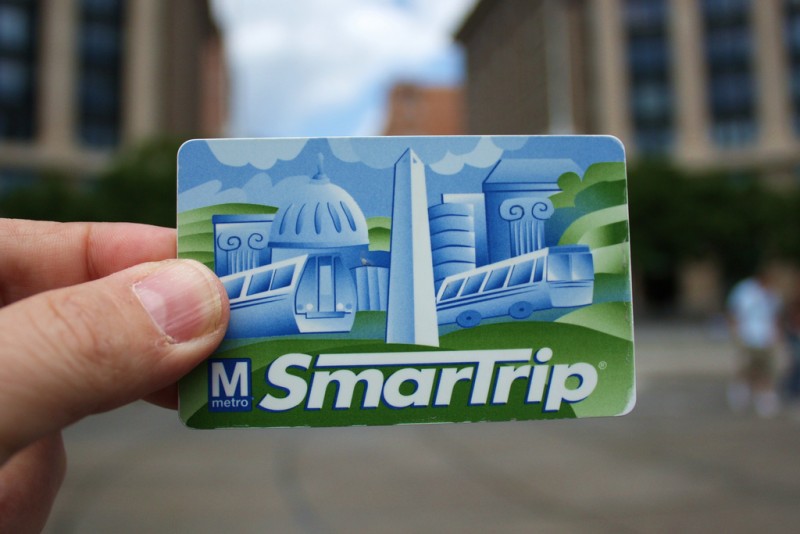What I learned from my first month using a Metro Select Pass

Image by Mr.TinDC licensed under Creative Commons.
I recently moved to Capitol Hill and started taking transit to work again. I was excited to finally be able to use the Metro Select Pass, a variable value pass designed for people who use Metro daily. I kept data on my travels for the month of March, and learned that to save the most money, I need to be very conscientious of how, exactly, I use Metro.
If you're not familiar, the way the Select Pass works is you pay for a particular fare value from one of nine price points, from $2.25 to $5.90. You then pay that fare multiplied by 36 (which is 18 round trips). You get any trips below the value you selected at no additional cost, and if you take a trip of higher value, you're only charged the difference.
For example, if you purchase the $3.00 value Select Pass (which costs $108.00), and you take a base fare trip of $1.75, you don't get charged anything. But if you take a trip that costs $3.25, you're charged 25 cents. A max fare trip of $5.90 would result in a $2.90 charge.
My travel log
During March, I took 64 trips on Metro. I rode 83 trains and 73 unique railcars. I entered or exited 25 different stations and rode on five of the six lines (I did not ride the Blue Line).
My trains were delayed by at least four minutes on ten different occasions. The worst delay was a 15 minute delay on March 20.
I could have saved more
My regular commute trip is from Union Station to Shady Grove. That trip costs $5.90.
Because of that, I chose to purchase the maximum fare Metro Select Pass. That meant that any trip I took on Metro was included; I never had to pay any overage fares.
The $5.90 Select Pass costs $212.40. To save money, I'd need to take trips worth more in value than that. And I did. I took $248.60 worth of Metro trips, so I saved $36.20.
But ironically, I would have saved more money with several other Select Pass value points. With the $4.00 value pass, I'd have saved $56.95. With the $3.75 value pass, I'd have saved $58.70.
The best pass, it turns out, was the $3.00 value pass. It would have saved me $60.55. Why? Because as it turns out, I don't take enough max fare trips.
I take short trips
My average trip during March was just $3.88. I only took 21 maximum fare trips. On the other hand, I took 29 trips that were $3.00 or less.
How do my travel patterns affect the savings from my Select Pass?
As one example, once a week I have to go to Silver Spring after work. That means that I drive to Glenmont, Metro to Silver Spring and then later, Metro home to Union Station. If I took a Shady Grove to Union Station trip, that would be $5.90. A rush hour Glenmont to Silver Spring trip costs $2.80 and an evening Silver Spring to Union Station trip costs $2.70. That's a total cost of $5.50. But the savings is based on each trip, not the sum. Yes, my $5.90 pass covers the $2.80 and $2.70 trips, but then, so would a $3.00 pass.
On days when I work late, my fare from Shady Grove is only $3.60. That also means that sometimes I'm overpaying for my pass.
If I regularly took the same max fare trip, at least 18 days a week, the $5.90 pass would definitely save me more money. But since I frequently substitute cheaper trips, a cheaper pass would have been more appropriate.
Bus is not included
Metro operates a transit system that includes both bus and rail. But bus is not included in the Metro Select Pass unless you purchase an additional $40 bus pass to add to it. Select Pass users without the bus option do not get a transfer discount when switching between bus and rail. They pay the full bus fare. That's unfortunate because it's not like Select Pass users aren't paying rail customers. It is just one more hurdle in creating an integrated transit option.
And even if I had wanted to add the bus pass, I couldn't. With the Metro Select Pass, which has nine price points, the bus pass is only available with two: the cheapest pass, $2.25, and the $3.75 price point. If you hold a different value pass, you're not able to add the bus pass. That's unfortunate, again, because bus is a vital part of the transit system. Many of the customers who seek out Select Passes are the heavy transit users who often need to use both bus and rail.
These economics did play into some of my transportation decisions. One night, I was traveling home from U Street to Capitol Hill. The 90/92 bus runs right behind my apartment on 8th Street, so it would have been very convenient and probably quicker for me to take the bus. But instead, I took rail because it was already paid for. It's a shame that the cost of the bus pass is an additional $40, because I'm unlikely to make $40 worth of bus trips. That means I pay full fare for the bus. I'm still likely to save money each month, but it does influence which modes I take.
I've already bought my $5.90 pass for April. I'll keep tracking my trips. But I'll likely buy a cheaper pass in May. I haven't decided about the bus option.
What about you?
Do you use the Metro Select Pass? If not, use our calculator to figure out what you can save and the right pass level to pick.
